Wednesday, January 26. 2011
Rachel Botsman Explains How Collaborative Consumerism Will Change Our World (Interview)
Via TreeHugger
-----
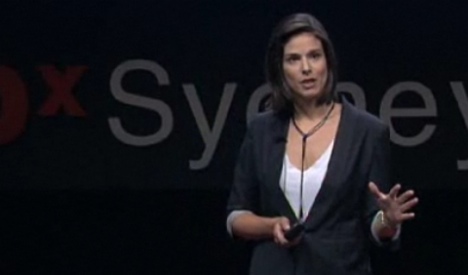
Image via TED
The rise of lending libraries, swapping sites, and product as a service systems over the last 5 years or so has been impressive. We've seen an upswing in everything from clothing swap parties to local rental communities, to big services like Zipcar for getting around without having to own a car and even AirBnB for renting spare bedrooms from locals rather than hotel rooms. Rachel Botsman is the co-author of the book What's Mine Is Yours: The Rise of Collaborative Consumption. She studies how we're switching to a culture of sharing, and how that will transform business, consumerism, and the meaning and impact of social networking in our lives. She took the time to answer a few questions from us about what's behind collaborative consumerism, and what we can expect over the next few years.
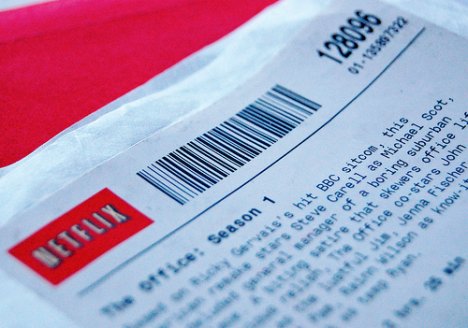
Photo by Jamiesrabbits via Flickr Creative Commons
Lending libraries, rental sites for stuff, and even car sharing is getting more popular these days. But what area of consumables have you seen the most growth in for sharing or swapping among community members?
Swapping sites for goods with limited value or that fulfill a temporary need such a baby goods, books and DVDs are growing at a staggering rate; Peer-to-peer space rental sites (homes, gardens, parking spaces, storage etc.) such as AirBnb, Landshare and Parkatmyhouse are exploding in mainstream popularity; Bike sharing is the fastest growing form of transportation in the world; Co-working spaces are popping up in the world's major cities; I think 2011 is the year that we start to see skill or 'favor' share communities such as TaskRabbit, Skillshare and Hey Neighbor start to take off.
As collaborative consumerism becomes more practical and popular, how do you think it will shift our economy as a whole?
Big picture (and I am talking in 10-20 years time), I think we will see the way we measure 'wealth', 'growth' and 'happiness' being completely redefined. We are already seeing countries such as the UK, Canada and France looking at reinventing measures beyond GDP that give a picture of the holistic well-being of a nation. As Sarkozy commented, "So many things that are important to individuals are not included in GDP."
The way assets and income are taxed is going to be an interesting area as more people become "micro-entrepreneurs" earning money renting out their assets or bartering their skills. Peer-to-peer marketplaces essentially cut out a lot of middlemen but in the process create a whole array of cottage industries. Just think of Etsy. It's going to be interesting to see whether big brands and global businesses retain their appeal or whether small really is the next big thing.
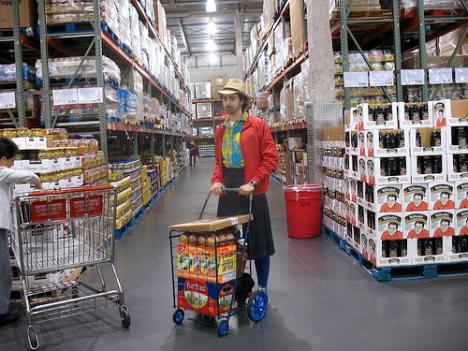
Photo by Orin Zebest via Flickr Creative Commons
Some of the big environmental benefits we can see with a culture of sharing goods is reduced production of stuff, and definitely less waste. What are some of the lesser seen eco-benefits we might see?
In short, a) better utilization of assets b) products designed for longevity not obsolescence and c) mindset and behavior change.
All around us, we are surrounded by stuff that has what I call 'idling capacity', the untapped value of unused or underused assets. There are different kinds of idling capacity. Products that are underutilized (e.g. the average car that sits parked for 23 hours a day); products that fulfill a temporary need (e.g. baby goods and clothes): or those that diminish in appeal and value after usage (e.g. a movie or a book). At the heart of Collaborative Consumption is how we can use the latest technologies to redistribute 'idling capacity' and maximize usage.
I could not think of a more exciting time to be a designer. Longevity does not just mean designing with durable materials but making goods with modularity that can be seamlessly updated, as well as easily broken down for future reuse, resale or repair. It will mean designing products that can be easily shared, customized and personalized by different users. If a designer had a blank sheet of paper and was designing a car for shared usage versus individual ownership how would it differ? How can we use RFID tags to embed stories, images, and videos into shared goods so they become smarter and more interesting than individually owned products? There are endless sustainable design opportunities...
When people start using different examples of Collaborative Consumption they frequently describe a 'mindset change.' There are examples like car sharing where users think twice about whether they need to drive and thereby reduce their miles travelled by an approximated 45%. And there are examples like peer-to-peer rental, where people are using platforms such as Neighborgoods or Snapgoods. 'Owners' are realizing they can make money from renting out their assets peer-to-peer and 'renters' are experiencing the benefits of not needing to own. Finally, you have examples like 'swap trading' where people suddenly realize they are surrounded by assets they can swap to get what they want versus buying new stuff. The behaviour becomes addictive.
How far do you think we are from having collaborative consumerism be a mainstream way of using goods, and what are some of the steps we still need to take to get there?
We are just in the nascent stages of Collaborative Consumption. We have already seen examples like Netflix, eBay and Zipcar become household names but that has taken a decade - technology and consumer values were playing catch-up. But I think the current massive cultural and technological shift is accelerating the next wave of Collaborative Consumption at an astonishing rate.
I think it's critical for more big brands to enter the space. BMW, Daimler and Peugeot have all recently launched car sharing models. Amazon just announced its 'Buy Back' scheme of second-hand unwanted books. I would love to see a big bank enter the social lending space; for a retail giant like Target to launch an innovative rental model; for a brand like Zappos to create a shoe swapping and repair platform....
Big brands can reach scale faster, they prove there are real business models behind Collaborative Consumption (and there are), but they also create the social proof, the cultural cache for this new cultural and economy to become mainstream.
More on Collaborative Consumerism
Meet Rachel Botsman and Roo Rogers Authors of What's Mine Is Yours
TED Talk: Systems of Sharing About to Revolutionize Consumerism
Related Links:
Tuesday, January 25. 2011
Une ère conditionnée
Via Libération
-----
By Sylvestre Huet
Récit - Le glaciologue Claude Lorius démontre que l’homme est devenu un «géo-ingénieur» climatique aussi puissant que les forces géologiques, et annonce l’anthropocène, l’ère de l’homme.
Iceberg dans les eaux antarctiques. (REUTERS)
-
More about this book, Claude Lorius and the Anthropocene directly on Libération.
Related Links:
Personal comment:
Anthropocene is a word we hear more and more about. It probably just gives a name to what we all observe everyday: that our environment is getting more an more artificial, conditioned at a global scale with ecological costs.
Humanity as a whole (and the consumption habits that came along with industry first, then re-inforced by capitalism) have become a geo-engineering force that is shaping the planet, with no effective couterparts at this day.
The question is maybe now how to critically "architecture" and reprogram this global scale and all what comes with it (so obviously, human habits are part of this), rather than if we can avoid it and go back to our "caves". At this point, the main force that drives globalism is the commercial one, this should change for something more valuable (for "les produits de "haute nécessité"", as Edouard Glissant would probably say).
Wednesday, January 19. 2011
Middle: Out of Sight
Via Frieze blog
-----
The legacy of Guy Debord and the connections between terrorist strategies, the networked 21st century and historical avant-gardes
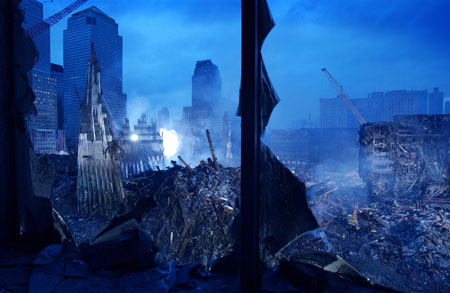
One of the most controversial comments made after 9/11 came from the avant-garde composer Karlheinz Stockhausen, who told a journalist in Hamburg that the attack was ‘the greatest work of art that is possible in the whole cosmos’. His comments caused uproar in Germany, where the association of art with political violence obviously raises troubling historical spectres. Whether or not Stockhausen was right to equate terrorism with art – and it would be disingenuous to deny the conceptual violence of his analogy, which he himself quickly recognized and sought to dampen – his comments point to an uncomfortable truth: for more than a century now, artists and terrorists have shared a common intention to produce reactions of shock in the spectator – in other words, to produce a spectacle. One need only think of the Futurists’ politics, or recall how the Iraq War was initially billed as a spectacle of ‘shock and awe’. Indeed, it is tempting to say that the past decade’s war on terror was a war of terror, in which violence and its mediatized exhibition fused to into one another and become two faces of a single aesthetico-political instrument deployed by states and ‘non-state actors’ alike. It is tempting to describe the ongoing global conflict as the outbreak of the first genuinely avant-garde war, one in which Modernist negation is efficiently integrated into a four-dimensional technological mediasphere conflict that is, to use the lingo du jour, viral.
None of this, of course, is news. Anyone with a glancing familiarity with 20th-century culture and critical thought knows that the intimate relation between mass spectacle and political violence hangs over it like a dark cloud. The list of thinkers who explore this territory is long. In recent years, Giorgio Agamben’s analysis of modernity as a ‘concentrationary’ biopolitics in books such as Homo Sacer (1998) and Remnants of Auschwitz (2002) have achieved iconic status. Before Agamben, there were works such as Paul Virilio’s study of the militarization of seeing, War and Cinema (1984), Marshall McLuhan’s The Medium is the Massage (1967) and Walter Benjamin’s famous 1936 essay ‘The Work of Art in the Age of Mechanical Reproduction’. All these writings insist in different ways on the continuity between modern communications media and political violence. Moreover, even though the historical avant-gardes are not shy about their use of a rhetoric of destruction, Thomas Crow reminds us that their acts of negation of traditional bourgeois culture have been appropriated by the spectacle from the outset: ‘Legitimated Modernism is in turn re-packaged for consumption as chic and kitsch commodities. The work of the avant-garde is returned to the sphere of culture where much of its substantial material originated […] In the 20th century, this process of mass-cultural recuperation has operated on an ever-increasing scale.’¹ Others see this recuperation in stronger terms. In Architecture and Utopia (1976) Manfred Tafuri identified the Dadaist negation of traditional bourgeois culture as the precondition for a ‘renewed bourgeoisie, capable of accepting doubt as the premise for the full acceptance of existence as a whole, as explosive, revolutionary vitality, prepared for permanent change and the unpredictable.’² For Tafuri, then, the art world may well represent the real shock troops of capital; the front lines of its domination and transformation of the means of production might well be places like Williamsburg and Berlin.
Today, however, one may well wonder to what extent the 20th-century pas de deux between the avant-garde and ‘society’ remains useful as a framework for thinking about art? If the spectacle has become the basis of a global war and terror, to what extent is negation still the critical gesture that defines the potential of progressive art? Does it even make sense to speak of a critical negation of society, or is the art world today simply a mobile and partly-sponsored research lab for capital? These are the questions ultimately provoked by Stockhausen’s comments.
At the minimum, it is undeniable that the ‘spectacular’ dimension of 20th-century mass culture is currently morphing into something that lacks an endoskeleton and can take any shape it likes, like a new generation Terminator. McLuhan’s medium-message is fragmenting into a dizzying variety of information packets delivered and consumed in ways that were difficult to imagine in the 1960s. More crucially, however, the relation between producers and consumers is in the midst of being entirely revolutionized, leading to the near-wholescale liquidation of what Frankfurt School theorists referred to as the ‘culture industry’. Blogging, social networking, tweeting and so on has flattened the hierarchy between producer and consumer. The culture industries – journalism, music, television, advertising and even cinema – primarily driven by the recuperation of the avant-garde into commodities and kitsch are being ‘rationalized’ and liquidated. The same functions are now being performed for free. The fans, critics, collectors and spectators who characterize 20th-century culture are becoming nodes in a network that realizes Warhol’s dictum regarding fame in a diminished and crepuscular version – one reserved for one’s circle of friends. Not everyone, as Joseph Beuys suggested, is an artist, but everyone has been given a technological form of self-expression and the status of a cultural worker whose taste will be archived and data-mined.
How do we think about this shift from a top-down structure into a viral mass-culture network in which the spectacle is simultaneously everywhere and nowhere – and perhaps soon reduced to a letter-box image displayed on a universal communicator device modelled on the iPad? Is this a game-changer for avant-garde practice, or just another turn of the same screw?
To answer these questions, it might be useful to consider the work of one of the avant-garde’s most mythical figures, the artist-thinker and self-proclaimed ‘strategist’, Guy Debord, the leader of the Situationist International (si) and author of Society of the Spectacle (1967). A law-school drop-out who participated in and soon broke with the Lettrist International centred in the early 1950s on the left bank of Paris, in 1957 Debord formed the si with a small group that counted, at different junctures, figures such as the Dutch painter Asger Jorn, the visionary architect Constant Nieuwenhuys, and, later, the art historian T. J. Clark. Ostensibly a collective endeavour, the si was nevertheless more Debord than anyone else. In addition to making a handful of films, including Society of the Spectacle (1973), Debord directed nearly all of its ‘activities,’ as its ‘secretary’ and edited its journal, the Internationale situationiste. The opening lines of the book are perhaps as good a place to start as any to begin to get a sense of his approach to the question of the spectacle: ‘The whole life of those societies in which modern conditions of production prevail presents itself as an immense accumulation of spectacles. All that was once directly lived has become mere representation.’³
I cannot hope to do justice here to the full scope of Debord’s thinking, but it’s possible to glimpse the sharp difference between his conception of the spectacle and that of media theorists such as McLuhan, for whom the spectacle amounted to the product and effects of the mass culture produced, regulated and dominated by communications technologies such as television, cinema and radio. For Debord the spectacle amounted to something far greater, ultimately nothing less than the whole of life in modern capitalist society, the form that structures social relations and society as such. Thus, for example, it was not cinema that produced the modern spectacle, but rather, the society of the spectacle that has given rise to cinema in its current incarnation: ‘It is society and not technology that has made cinema what it is. The cinema could have been historical examination, theory, essay, memories. It could have been the film which I am making at this moment.’4 As Thomas Y. Levin has noted, while cinema and television may well be privileged figures of the spectacle, in point of fact, they are merely expressions of a specific social situation. The spectacle is ‘not a collection of images,’ but rather ‘a social relation between people that is mediated by images’.5 In other words, for Debord, the notion of spectacle was not any particular technology or form of media, but rather the general condition of representation that includes within it the consumption of mass-produced images that we commonly associate with television, for instance, or the Hollywood ‘dream machine’.
In many respects, it is tempting to see Tafuri’s skeptical diagnosis of the avant-garde’s complicity with modern capitalism as being equally applicable to Debord and the si, who undeniably continued previous avant-garde gestures of negation. At the same time, the practices of the dérive, defined as ‘transient passage through varied ambiances,’ and détournement, defined as ‘the integration of present or past artistic production into a superior construction of a milieu,’ are not reducible simply to acts of negation. Instead, they are attempts to create situations, and they extended the gesture of production beyond the purview of art, opening social forms to renegotiation as historical forms by revealing their underlying aesthetic foundations. In these, Debord the guerilla making raids on the perimeter of the occupying power is doubled by the romantic seeking the cozy warmth of direct and unmediated experience. One can easily object, of course, that there is no such thing as immediate experience, and yet, it was in the name of ‘life’ that Debord denounced previous vanguard movements as mere art: ‘Dadaism sought to abolish art without realising it; Surrealism sought to realise art without abolishing it. The critical position since developed by the Situationists demonstrates that the abolition and the realisation of art are inseparable aspects of a single transcendence of art.’
What can transcend art and mediate ‘life’? Is such a project nonsensical from the beginning and does it result in the imperial expansion of the art world? This question is not entirely simple, but Debord offers clues. In a letter to André Frankin of January 26, 1960, he writes: ‘I think that the “progressive” notion of the book excluded the pursuit of perfection, and any sort of completion. Formally and practically theoretical thought seeks its expression in a system of fragments, it seems to me. I am pleased with your comments about Passage [On the Passage of a Few People Through a Rather Brief Moment in Time, 1959] because criticism – or praise – has no true interest than when it emerges onto a collaborative perspective.’6 The ‘system of fragments,’ as it happens, is none other than Society of the Spectacle, where he pursues the thought in the following way: ‘Détournement is the antithesis of quotation, of a theoretical authority invariably tainted if only because it has become quotable, because it is now a fragment torn away from its context, from its own movement, and ultimately from the overall frame of reference of its period and from the precise option that it constituted within that framework. Détournement, by contrast, is the fluid language of anti-ideology. It occurs within a type of communication aware of its inability to enshrine any inherent and definitive certainty. This language is inaccessible in the highest degree to confirmation by any earlier or supra-critical reference point.’7 A lot of ink has been spilled on the status of citation in art, but here Debord identifies détournement not simply as appropriation in the name of cultural critique, but rather as a gesture that breaks the image down, turning it into a practice of writing whereby it no longer answers to the purposes of instrumental or political power and fails to support the creation of conceptually hardened positions. The fragment, it seems, fails to become a work, and cannot therefore become the citational basis for a theoretical or aesthetic judgment. What is created in the situation is a momentary passage that cannot become the aesthetic basis of a political position because it takes the form of a phrase, words situated amongst each other. It is in this, it seems, that Debord sought to transcend the complicity of the avant-garde and the spectacle as he defines it. The fragment can be identified with no medium and no conceptual formation, and as a result, in spite of his reputation for semi-Stalinist purges in the si, it seems to resemble a messianic paradigm generally associated with thinkers such as Benjamin instead of more directly engaged figures such as Brecht.
The fragment implies a poetics of art that does not seek to create an aesthetic shock in the spectator – and does not, contrary to recent ideas about ‘participation’, imagine a spectator at all. It should, moreover, also be distinguished from the highly fragmentary nature of what takes place and what is exchanged in the sphere of social media. The primary difference, it is tempting to say, is that whereas the former produces an aestheticized social experience that fully integrates expression and taste into an economic model of spectacle, Debord’s notion of the fragment is expressly set against information and only opens onto ‘life’ insofar is it interrupts the closed-circuit of information and sharply calls into question the fantasy of an archive identical to the society that produces it. In this, it recalls Nietzsche’s praise of the salutary effects of forgetting. For this reason, however, to remain true to this idea of language implies the paradoxical need to resist elevating Debord to an exemplary model for either art practice or a theory of politics. Rather, one is tempted to see in him a figure who plays ‘in blissful blindness between the fences of the past and future.’8
1 Thomas Crow, ‘Modernism and Mass Culture in the Visual Arts,’ in Modern Art in the Common Culture (New Haven: Yale University Press, 1996), p.35
2 Cited by Thomas McDonough ‘Ideology and the Situationist Utopia’, his introductory essay to Guy Debord and the Situationist International, ed. Thomas McDonough (Cambridge, mit Press, 2002), p.x
3 Guy Debord, Society of the Spectacle, trans. Donald Nicholson-Smith (New York: Zone Books, 1995), p.12 4 Guy Debord, In girum imus nocte et consumimur igni, in Oeuvres cinématographiques completes, 1952–78 (Paris, Editions Champ Libre, 1978), p.207–8
5 Debord, Society of the Spectacle, p.146
6 Guy Debord, Correspondence: The Foundation of the Situationist International (June 1957–August 1960) (Los Angeles, Semiotexte 2009), p.320
7 Debord, Society of the Spectacle, p.146
8 Friedrich Nietzsche, ‘On the Utility and Liability of History for Life,’ in Unfashionable Observations (Stanford, Stanford University Press, 1995), p.88
Saul Anton
Monday, January 17. 2011
Des millions de Little Brothers nous surveillent
Via L'Hebdo, Christophe Schenk
---
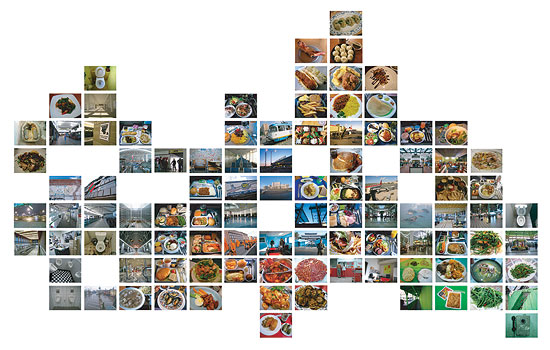
Bien avant Facebook ou Twitter, Hasan Elahi a pris l’habitude de partager sur le Net ses allées et venues, ses faits et gestes.
Artiste et professeur à l’Université du Maryland, l’Américain de 38 ans se met en scène à travers un work in progress original, intitulé Tracking Transience: The Orwell Project.
Sur son site internet, des milliers de photographies apparaissent, sous la forme de mosaïques thématiques, instants quotidiens accumulés depuis plus de sept ans. Panneaux autoroutiers, assiettes remplies de nourritures variées, urinoirs et toilettes publics, rien n’est oublié pour façonner un carnet intime au format numérique, plus provocateur qu’égocentrique, moins geek que citoyen.
Démarche artistique et acte politique, le travail de Hasan Elahi trouve en effet son origine en juin 2002, à l’aéroport de Detroit. De retour d’un séjour au Sénégal, où il exposait ses œuvres, l’artiste – Américain, mais originaire du Bangladesh – est arrêté à la douane et interrogé par des agents du FBI. On le soupçonne de cacher des armes dans un entrepôt et de collaborer avec des réseaux terroristes.
Parmi les questions qui lui sont posées, l’une va déterminer son action future: où était-il le 12 septembre 2001, au lendemain des attentats contre les Twin Towers? «J’ai pu répondre grâce à mon Palm, raconte Hasan Elahi, dont l’agenda avait conservé mon emploi du temps.» Si elles lui ont sauvé la mise une fois, les nouvelles technologies pourraient bien lui servir à nouveau.
Offre et demande. Interrogé fréquemment durant six mois, puis blanchi après s’être soumis au détecteur de mensonge durant trois heures, Hasan Elahi n’est pas rassuré pour autant.
«Je parcours plus de 100 000 kilomètres par année et prends souvent l’avion, explique-t-il. Je leur ai donc demandé de me fournir un document officiel, qui me laverait de tout soupçon. Ils ont refusé, mais m’ont répondu que je pouvais leur téléphoner la veille de mon voyage et qu’ils feraient le nécessaire pour que je n’aie pas de problèmes.»
Prenant les agents du FBI au mot, il décide de les appeler avant chacun de ses déplacements à l’étranger. Avant de choisir d’aller plus loin encore et de mettre sa vie en ligne au jour le jour, via un site internet dédié.
Grâce au GPS intégré dans son téléphone portable, Hasan Elahi est localisable en temps réel, tandis que des photos ajoutées chaque heure documentent ses actions, de ses repas à ses activités professionnelles, en passant par ses rencontres.
«Quand j’ai constaté que le FBI avait un dossier sur moi, j’ai choisi d’appliquer un principe économique simple, explique-t-il, à savoir la loi de l’offre et de la demande. En inondant le marché d’informations à mon sujet, celles relevées par le FBI perdraient irrémédiablement de leur valeur.»
Une démarche à laquelle s’ajoute un second principe, toujours plus en vogue à l’heure du règne de Google et de l’impossible anonymat: c’est quand on en dit le plus qu’on en révèle le moins.
«Sur mon site, on trouve des tas de petites informations sur moi, mais aucune qui ait vraiment de l’importance ou de la valeur. Jusqu’à il y a peu, certaines des organisations qui m’invitaient pour des conférences ne parvenaient même pas à trouver mon âge.»
Contrôler son identité. Si certains de ses proches ont accueilli ce projet avec un brin de nervosité – Hasan Elahi prend également des photos lorsqu’il est invité chez des amis, tout en prenant soin de ne pas dévoiler d’éléments qui permettraient de les reconnaître – ils ont rapidement cessé d’y prêter attention.
«Depuis le début de mes travaux, la culture a beaucoup changé, observe l’artiste. Par exemple, mes parents sont aujourd’hui mes visiteurs les plus réguliers, tout heureux de pouvoir savoir où je suis en continu. D’une certaine manière, ce type de documentation est peut-être le rêve de nombreux parents aujourd’hui.»
Une démarche qui ne diffère finalement guère des habitudes apparues ces dernières années avec l’avènement des blogs puis des réseaux sociaux.
Des sites qui permettent de suivre à la trace ceux qui s’y inscrivent et semblent sonner le glas des secrets, à la manière de Wikileaks. A moins que ce ne soit le contraire.
«Il ne faut pas oublier qu’avec ces sites, nous sommes désormais à la fois producteurs et consommateurs d’informations, note Hasan Elahi. On peut donc prendre le contrôle du système dans le même temps que l’on s’y intègre.»
Ainsi, il ne s’agit plus d’être la simple victime des systèmes de surveillance, mais de rediriger ceux-ci, par les moyens qui nous sont donnés. «Aujourd’hui, il suffit d’avoir un téléphone portable pour pouvoir prendre des photos ou filmer des séquences. Big Brother a été supplanté par des millions de Little Brothers. Et je ne suis pas sûr qu’il apprécie vraiment.»
Un peu plus de huit ans après sa première confrontation avec le FBI, Hasan Elahi poursuit toujours son œuvre via son site web. Sans même s’en rendre compte.
«C’est devenu une habitude, au même titre que consulter mes mails, les messages sur mon répondeur ou les réactions sur ma page Facebook, observe-t-il. Surtout, j’ai pu mettre en place des mécanismes automatiques au point que je ne me rends même plus compte que j’alimente mon site.»
Relayé dans les circuits artistiques, médiatiques ou technologiques, Tracking Transience a fait la renommée de Hasan Elahi, le posant en analyste confirmé des mutations que connaissent nos identités sur le Net. Le FBI pensait tenir un dangereux terroriste, il a donné naissance à un activiste de l’ère numérique.
Related Links:
fabric | rblg
This blog is the survey website of fabric | ch - studio for architecture, interaction and research.
We curate and reblog articles, researches, writings, exhibitions and projects that we notice and find interesting during our everyday practice and readings.
Most articles concern the intertwined fields of architecture, territory, art, interaction design, thinking and science. From time to time, we also publish documentation about our own work and research, immersed among these related resources and inspirations.
This website is used by fabric | ch as archive, references and resources. It is shared with all those interested in the same topics as we are, in the hope that they will also find valuable references and content in it.
Quicksearch
Categories
Calendar
|
|
January '11 |
|
||||
| Mon | Tue | Wed | Thu | Fri | Sat | Sun |
| 1 | 2 | |||||
| 3 | 4 | 5 | 6 | 7 | 8 | 9 |
| 10 | 11 | 12 | 13 | 14 | 15 | 16 |
| 17 | 18 | 19 | 20 | 21 | 22 | 23 |
| 24 | 25 | 26 | 27 | 28 | 29 | 30 |
| 31 | ||||||

